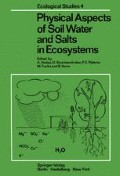Abstract
Electronic computers have stimulated a great deal of interest in numerical solutions to unsteady unsaturated flow. For the hydrologist, the interest does not lie so much in the determination of the soil moisture profile, but rather in the prediction of infiltration rates. The implication is that a rough determination of the moisture profile is legitimate provided that the prediction of infiltration remains good.
Access this chapter
Tax calculation will be finalised at checkout
Purchases are for personal use only
Preview
Unable to display preview. Download preview PDF.
References
Adrian, D. D., Franzini, J. B.: Impedance to infiltration by pressure build-up ahead of the wetting front. J. Geophys. Res. 71, 5857–5863 (1966).
Brustkern, R. L., Morel-Seytoux, H. J.: Analytical treatment of two-phase infiltration. J. Hydraulics Div., ASCE 96, 2535–2548 (1970).
Carrier, G. F.: Boundary layer problems in applied mechanics. Adv. Appl. Mech. 3, 1–18 (1953).
DeWiest, R. J. M. (Ed.): Flow through porous media. New York: Academic Press 1969.
Free, J. R., Palmer, V. J.: Relationship of infiltration, air movement, and pore sizdxe in graded silica sand. Soil Sci. Soc. Amer. Proc. 5, 390–398 (1940).
Le Fur, B.: Influences de la capillarité et de la gravité sur le déplacement nonmiscible unidimensionel dans un milieu poreux. J. Mecan. 1, (1962).
Peck, A. J.: Moisture profile development and air compression during water uptake by bounded porous bodies: 3. Vertical columns. Soil. Sci. 100, 44–51 (1964).
Philip, J. R.: The theory of infiltration: 1. The infiltration equation and its solution. Soil Sci. 83, 345–357(1957).
Editor information
Editors and Affiliations
Rights and permissions
Copyright information
© 1973 Springer-Verlag Berlin · Heidelberg
About this chapter
Cite this chapter
Morel-Seytoux, H.J., Noblanc, A. (1973). Infiltration Predictions by a Moving Strained Coordinates Methods. In: Hadas, A., Swartzendruber, D., Rijtema, P.E., Fuchs, M., Yaron, B. (eds) Physical Aspects of Soil Water and Salts in Ecosystems. Ecological Studies, vol 4. Springer, Berlin, Heidelberg. https://doi.org/10.1007/978-3-642-65523-4_3
Download citation
DOI: https://doi.org/10.1007/978-3-642-65523-4_3
Publisher Name: Springer, Berlin, Heidelberg
Print ISBN: 978-3-642-65525-8
Online ISBN: 978-3-642-65523-4
eBook Packages: Springer Book Archive

